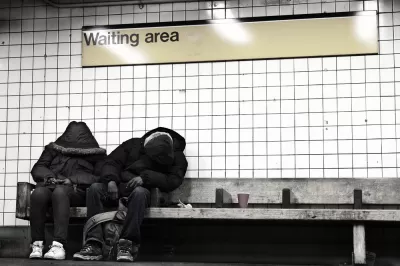Downzoning and building height restrictions have kept supply well behind demand in New York City, according to this article.

"There are currently about 59,000 New Yorkers staying in homeless shelters and several thousand more sleeping on the streets, figures that fluctuate seasonally," Ben Adler writes for City and State New York. Others would rent but are forced to stay with friends and family because they cannot afford the city's high rates. "Add it all up, and New York City’s homeless rate is the highest it has been since the Great Depression, even as the national economy verges on full employment," Adler writes.
Rents have risen twice as fast as wages in the city since the recession. And competition is fierce at the low end of the rent scale. Besides the problem of scarcity driving the prices of affordable homes, there's simply not enough cheaper housing for all the people who would rent it. "The major increase in homelessness is among people who simply lack a place to live and wind up in a homeless shelter. In May, there were 15,023 families, with 22,538 children, sleeping each night in New York City’s municipal shelters, according to the Coalition for the Homeless," Adler reports.
While New York Mayor Bill de Blasio has done some work to allow for more homes near transit, Midtown New York has imposed new height restrictions. Adler argues that this process of treading water on housing production is exacerbating the New York's homelessness issue.
FULL STORY: Homelessness is a housing problem

Alabama: Trump Terminates Settlements for Black Communities Harmed By Raw Sewage
Trump deemed the landmark civil rights agreement “illegal DEI and environmental justice policy.”

Planetizen Federal Action Tracker
A weekly monitor of how Trump’s orders and actions are impacting planners and planning in America.

Why Should We Subsidize Public Transportation?
Many public transit agencies face financial stress due to rising costs, declining fare revenue, and declining subsidies. Transit advocates must provide a strong business case for increasing public transit funding.

Understanding Road Diets
An explainer from Momentum highlights the advantages of reducing vehicle lanes in favor of more bike, transit, and pedestrian infrastructure.

New California Law Regulates Warehouse Pollution
A new law tightens building and emissions regulations for large distribution warehouses to mitigate air pollution and traffic in surrounding communities.

Phoenix Announces Opening Date for Light Rail Extension
The South Central extension will connect South Phoenix to downtown and other major hubs starting on June 7.
Urban Design for Planners 1: Software Tools
This six-course series explores essential urban design concepts using open source software and equips planners with the tools they need to participate fully in the urban design process.
Planning for Universal Design
Learn the tools for implementing Universal Design in planning regulations.
Caltrans
Smith Gee Studio
Institute for Housing and Urban Development Studies (IHS)
City of Grandview
Harvard GSD Executive Education
Toledo-Lucas County Plan Commissions
Salt Lake City
NYU Wagner Graduate School of Public Service





























